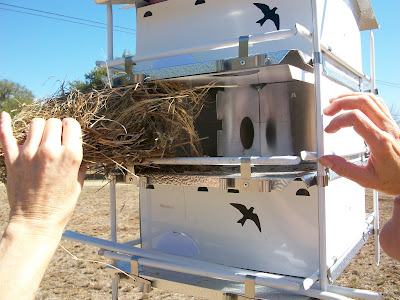Once upon a time, while cruising the Web on a research mission, I ran across a page that talked about making a bee nest box for solitary bees, which are important pollinators, too. That sounded so cool, but that's as far as I went.
Until today. I made one!
It was very simple. I used basic directions that you'll find in
Providing for Backyard Wildlife, published by the Texas Parks and Wildlife Department and written by Walter Brown of
Belton.

First, I bought a
untreated cedar post and had two blocks cut at 7 inches long. On one block, James cut off an angled inch from the top. Then I drilled the eight holes, using a 5/16-inch bit. The holes MUST be one inch a part and one-and-a-quarter inches deep. I also inserted straws to help insulate from moisture. Then I hung it on the side of a dead tree on our adjoining lot. I'll make a second one later and hang it somewhere else.
According to Mr.
Brown, species that use nest boxes include mason, digger, carpenter, sweat and plasterer bees. They're not considered to be "social" bees, like honey bees. But they do like to nest close to one another. Females
deposit a mixture of pollen and nectar at the end of the hole. After laying one egg, they close the hole. The grub hatches, eats the food, and pupates.
Voila! A new bee!
We'll see if we can get takers. Stay tuned!
In
the meantime, here's more information from the
National Wildlife Federation on how to build a bee house:
With drill bits of various sizes (5/16
th of an inch works best for Mason bees) simply take some scrap lumber and drill holes 3 to 5 inches deep but not all the way through the wood block. For example, get a 4 inch by 4 inch piece of wood and drill holes that are 3 and 1/2 inches deep.
You can cover the holes with chicken wire to help keep birds away from the bee house.
Securely place the bee house on the south side of buildings, fence posts, or trees.
Scatter some of the houses throughout your community. You may find an excellent location to trap some bees and then move them to your location.
DO NOT move bee houses after they are in place until at least November.
DO NOT spray insecticides on or around bee houses.
If you choose to build your own bee houses, DO NOT use treated wood.
* * *
An important reminder from the
Tucson Botanical Gardens (where you can find more directions on making your own box): Remember to clean your bee box every year using a solution of one quart of water and one tablespoon of bleach. This disinfects the box and eliminates any mites or pests harmful to the bees.

 After we bought the adjoining lot to our home, we were excited to find many native plants, including a young redbud tree. I'd forgotten about the redbud until James spotted the pretty little blooms yesterday. It's definitely a redbud because the tiny leaves are already heart shaped.
After we bought the adjoining lot to our home, we were excited to find many native plants, including a young redbud tree. I'd forgotten about the redbud until James spotted the pretty little blooms yesterday. It's definitely a redbud because the tiny leaves are already heart shaped.















































